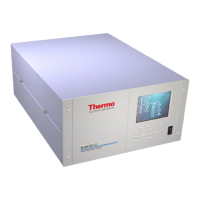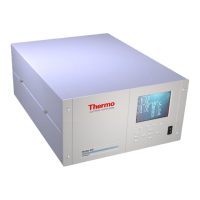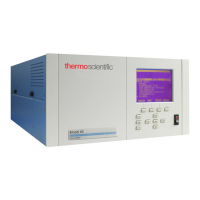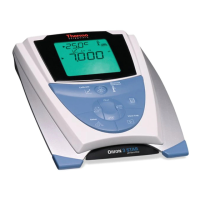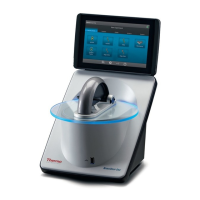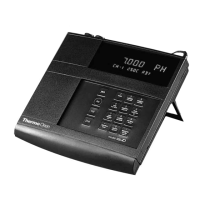Daily Operation
Things to Do Before Operating the LTQ
@@@@@@@@@@@@@@@@@@@@@@@@@@@@@@@@@@@@@@@@@@@
'JOOJHBO-52
5IFSNP
&-&$530/$03103"5*0/
3-4 _______________________ Finnigan LTQ Hardware Manual _______________________
Checking the System Vacuum Levels
For proper performance, your LTQ system must operate at the proper vacuum
levels. Operation of the system with poor vacuum levels can cause reduced
sensitivity, tuning problems, and reduced lifetime of the electron multiplier.
You should check your system for air leaks by checking the system vacuum
levels before you begin your first acquisition.
You can check the current values of the pressures in the capillary-skimmer
region and foreline (labeled Convectron Gauge Pressure) and in the analyzer
region (labeled Ion Gauge Press) in the Vacuum dialog box of the Tune Plus
window. To display the Tune Plus window choose Start > Programs >
Xcalibur > LTQ Tune. Choose Setup > Vacuum to display the Vacuum
dialog box.
Compare the current values of the pressures in the vacuum manifold with the
values listed in Table 3-1. If the current values are higher than normal, you
may have an air leak.
If the pressure is high (above 5 x 10
-5
Torr in the analyzer region), and you
have restarted the system within the last 30 to 60 minutes, wait an additional
30 minutes and recheck the pressure. If the pressure is decreasing with time,
check the pressure periodically until it is within the typical pressure range of
the MS detector.
If the pressure remains high, your system may have an air leak. If you suspect
an air leak, shut down the system as described in the topic Shutting Down the
System Completely on page 6-4. Make a visual inspection of the vacuum
system and vacuum lines for leaks. Check each fitting and flange on the
system for tightness, and tighten the fittings or flanges that are loose. Do not
tighten fittings indiscriminately. Pay particular attention to fittings that have
been changed recently or to fittings that have been subjected to heating and
cooling. Make sure that the cover plates of the vacuum manifold are properly
seated.
Note. Major air leaks are often identifiable merely by listening for a rush of
air or a hissing sound somewhere on the instrument. A major leak might be
caused, for example, by a loose or disconnected fitting, by an O-ring that is
not properly seated, or by an open valve.
Table 3-1. Typical Pressure Readings
Conditions Convectron gauge reading
(foreline, capillary
skimmer region)
Ion gauge reading
(analyzer region)
Ion transfer capillary orifice open,
ion transfer capillary at 250
°C
1.0 to 1.5 Torr 0.75 x 10
-5
to 1.5 x 10
-5
Torr
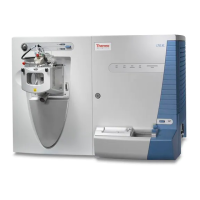
